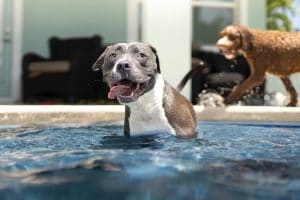Can all dogs swim is a common question thanks to the misconception that all dogs have the natural ability to swim safely which is exaggerated with clips online of water-loving breeds such as labradors gliding through effortlessly and throwing themselves into any body of water they come across.
Just like humans, if a dog is thrown into the water their natural instinct through ‘fight or flight’ which in this case is to paddle, hence the name doggy paddle. The reality is, however, that many breeds of dog would not know what to do next and how to safely swim back to shore or in the direction they desire let alone know how to dive in.
There are plenty of benefits to swimming for dogs but this doesn’t mean that all dogs should be forced to do so, some dogs just can’t swim well and do not like it.
If you’re wondering whether your puppy or dog is a breed that might enjoy a trip out to water then we’ve written this handy guide to help you find out safely and whether or not it’s worth attempting at all. Just to reiterate, not every dog is a swimmer dog and being able to doggy paddle and not drown is NOT a sign that they can actually swim or that they enjoy it.
How do you know if your dog can swim?
Below are a couple of key features that naturally water-loving dogs swimming have in common and you can see if your dog has most of them
Long legs
Mutts with long legs are able to move quicker through the water as they are essentially their oars while swimming. Long-legged pooches are able to stroke more through the water to gain enough speed to stay buoyant in the water.
Breeds with short legs such as Pugs and Daschunds struggle a lot in water as they can not get enough power in the water to wade through the resistance water creates. Short legs is usually a red flag if you want to find out if dog swimming is possible for you and your furry friend.
Large paws
Large paws are key to swimming efficiently and safely. In general, breeds with large paws such as Labradors, Golden Retrievers and Great Pyrenees are natural swimmers because of the ability to push enough water to propel themselves forward.
Most breeds with large paws also have webbed feet such as the Portuguese water dog which should give you a clue that they are born to swim. Some may refer to these kinds of paws as paddle paws which gives them a tremendous advantage in the water.
Streamlines bodies
Streamlined bodies help the dog stay buoyant in the water and allow them to glide through the water with all 4 legs able to spread the work. Breeds which have large chests struggle as the weight is uneven making the front legs have to work harder which can exhaust them quickly.
Although large-chested breeds can still have a paddle it can certainly be more of a challenge. Breeds such as Pitbulls, Bulldogs and Pugs, however, have large chests and shorter legs making the task extremely laborious to the point where it is not fun and potentially dangerous for them.
It is much easier for a swimming dog to cope if they do not have extra muscle and bone density weighing them down – this is especially true when they initially jump in as it can be hard work getting back to the surface.
Long Muzzle
Long muzzles allow your dog to keep their nose clear above the threshold to keep breathing while they paddle. When dogs glide most of their body is underwater and usually, their head is just above.
Breeds with short muzzles such as Bulldogs (see also ‘Old Tyme Bulldog‘) struggle to keep their head above water putting them at risk of ingesting too much water (which can lead to water intoxication) and breathing. They are at a much higher risk of drowning. Short muzzles is another red flag.
Even composition
Those with an even distribution of muscle and fat are more likely to be able to have a splash and enjoy it. As mention previously, breeds with an abundance of muscle is heavier and will tire out quicker while breeds with lean bodies such as Whippets (see also ‘The Ultimate Guide To Bedlington Whippets Lurchers‘) and Greyhounds will struggle to stay warm.
Short to standard coats
All dog coats secrete oils which allow them to be somewhat waterproof or at the very least moisture wicking. However, some breeds which coincidentally are water-loving breeds have more active oil glands than others which makes their coat waterproof and keeps their skin from getting wet which can lead to hypothermia and other cold-related issues.
But, some breeds with very short coats or extra thick coats can struggle as they will either get too cold (short coats) or their fur will become waterlogged and heavy (long and thick coats). This extra weight adds more work for the dog to do to stay afloat.
Do dogs like to swim?
Not all dogs like to swim, even those who can. First and foremost, try and deduce if your loyal companion has the traits needed to be a good swimmer and then gently introduce them to water sports – a paddling pool is a safe way to start.
Most dogs do like physical activity – dogs love to hear the word walkies for example and thrive in the great outdoors. Swimming is just another kind of physical activity and may well love it but the phrase ‘each to their own’ applies here. Maybe your dog loves it maybe they don’t.
What breeds of dog can swim?
There are too many dog breeds in the world which can swim to name them all, however, here is a shortlist of the most notorious swimming dogs.
- Poodle
- Labrador Retriever
- Golden Retriever
- Newfoundland
- Irish Water Spaniel
- English Setter
- American Water Spaniel
- Otterhound
- Beagle
As you can see there are a lot of similarities between these breeds such as large paws, long legs, standard coats and even composition. If you have one of these breeds then you can guarantee a good time at the beach or lake.
What breed of dog can not swim?
The following breeds are not natural swimmers
- Pug
- Daschund
- Maltese
- Bulldog
- Basset Hound
- Corgi
- Staffordshire Bull Terriers
- Shih Tzu
- Chihuahua
If you have any of the above breeds then encouraging them to swim is likely to end in disappointment.
Can a dog drown?
Dogs can drown in water just like any other air-breathing animal if they can’t stay afloat. Even breeds that can swim can drown if they are unable to get to shore and tire out whilst wading which is why we recommend to only let them paddle in safe waters and never throw your furry friend in.
Dogs who can’t swim are more likely to drown, obviously, and can do so quite easily if they are thrown in or accidentally enter a body of water.
Dogs are also susceptible to something called ‘near-drowning’ if they are to ingest too much water while in water
So, can all dogs swim?
Not all dogs are able to swim naturally and not all dogs will enjoy it either. Dogs have preferences and particular things they like and dislike just like us so it’s all about safely introducing water to them to find out. Breeds that can’t handle the aqua well can still enjoy a paddle in shallow water.
Some breeds, however, are naturally poor at diving in and should never really take to an open body of water without a life vest. Others are swimmer dogs plain and simple.
Do you have a dog that loves or hates it? Do you have a great story of a dog that is naturally not great at swimming but seems to love it? We’d love to know your thoughts in the comments section.
We hope we’ve been able to help with the whole dog swimming myth and provide some tangible advice for you.


